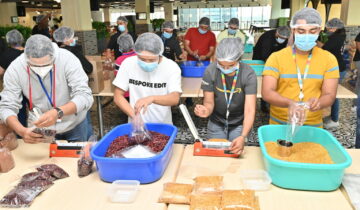Growing up in a joint family in the city of Kanpur, certain habits were inculcated amongst all children. One of these was savings in a gullak (Hindi for earthen money box). These savings, in paisas, were essentially made from gifts given by visiting relatives or on certain festivals and, occasionally, the loose change pocketed when we were sent to the shops. Every now and then, we were asked to break our gullak — it was the only way to take the money out — and share some of those savings with certain “causes” supported by our family of teachers. Two of the most prominent ones I remember donating to were a local orphanage (where my mother served on a managing committee) and cultural activities organised in our neighbourhood between Dussehra and Diwali, or Sankranti and Shivratri (two periods — October and February/March — roughly coinciding with autumn and spring seasons in North India).
Little did I realise that this practice will be called charitable giving or philanthropy!
This type of giving — of time, skills and monetary contributions, including assets — has been an integral part of Indian society. All religions born and practiced in the Indian subcontinent encourage giving for the wellbeing of the needy.
From feeding birds and animals to pyayu, a custom in North India (providing drinking water to passers-by), these are universal practices of giving, much of which is second nature to us. These practices of contributing to the wellbeing of others, a larger societal good, were part of the socialisation of growing up in this region.
In pre-Independence India, Mahatma Gandhi called upon citizens and the business community to support constructive social work practices to encourage mobilisation of volunteers for the freedom struggle against the British empire. Their support was critical.
Recently, the pandemic also shone the spotlight on the almost-invisible, small-scale, locally-rooted practices of philanthropy, a tradition described earlier in this essay. Neighbours provided food to residents of informal settlements, volunteers provided medicines to sick families, local animators in far-flung villages translated and disseminated COVID-19 standard precautions and government directives. Migrant workers and their families were provided with shoes, water and food as they walked home in the summer heat. Local gurudwaras, temples, mosques and churches offered shelter and food to the needy, and able-bodied middle-class citizens drove sick people to hospitals in their own cars. Volunteers ferried oxygen cylinders to clinics, hospitals and people’s homes; local youth organised village quarantine facilities for returning families and workers.
The rise of everyday philanthropy was as momentous, spontaneous and widespread as the COVID-19 infections in India!
These everyday, hyper-local, small-scale, family-driven philanthropic efforts are not a part of the national and international discourse on philanthropy. Their stories do not attract the attention of policymakers and the media. They remain invisible, informal, below the radar! Yet they are widespread and effective. The first and only nationwide survey of the nonprofit sector conducted nearly 20 years ago captured this essence of everyday giving in this country. Nearly 40% of all households give for charitable causes; two-thirds of all givers live in rural areas; two-fifths of all giving households belong to poor households (annual income below ₹25,000); two-fifths of all giving households had education only up to primary levels. This trend of household giving received a new impetus during the recent pandemic, as evidenced by the many media reports from all corners of the country. Whither will Indian philanthropy go in the future?
It is important to acknowledge the diversity of practices and forms of philanthropic giving, from everyday charity to fellow citizens to large-scale investments in service provision. The essential challenge for all philanthropy is to link it to the giver’s vision of a desirable future for the community, a sort of “good society”.
Recognising and valuing this diversity will make philanthropy more sustainable in the years ahead.
Written by Dr Rajesh Tandon
This excerpt is from the book A New Era of Giving: Reflections on Philanthropy for Social Justice by ISDM Centre for Philanthropy for Inclusive Development. This book is a pioneering collection of essays on redefining the scope of philanthropy. It covers a wide range of topics, including the role of philanthropy in advancing social justice, the importance of ethics and embracing risk, the emergence of new philanthropic models and the importance of centering affected communities in all philanthropic efforts.
You can download the e-book and read the whole article by clicking here.
Image by jcomp on Freepik


